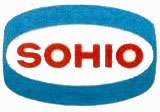Standard Oil of Ohio
Standard Oil of Ohio or Sohio was an American oil company, and the earliest component of the original Standard Oil company founded by John D. Rockefeller. Sohio was acquired by British Petroleum, now called BP.
 | |
| Industry | Oil |
|---|---|
| Fate | Acquired by BP |
| Founded | 1870,[1] 1911 |
| Defunct | 1991:
|
| Headquarters | , |
Sohio continued as a separate entity after the antitrust breakup of Standard Oil in 1911. It operated service stations under the "Sohio" brand name in Ohio. In other states, it used the "Boron" brand name instead, but with an otherwise-similar logo. Wallace Trevor Holliday was President of the company from 1928 to 1949 and Chairman of the Board from 1949 until his death on November 7, 1950.
In 1968, Sohio's CEO, Charlie Spahr, arranged a merger with BP. It was announced as Sohio's acquisition of BP's North American interests. However, the contract included a stipulation that BP would assume majority interest when Sohio's share of production from the Prudhoe Bay oilfield in Alaska reached 600,000 barrels per day (95,000 m3/d). That occurred in 1978, and BP then took control of Sohio. By 1991, BP had rebranded all Sohio-owned stations as BP, except for some marine fuel outlets.[2]
Stations
By 1980, Sohio and Boron had 3,400 gas stations in Ohio, Michigan, Pennsylvania, Indiana, Kentucky and West Virginia. Sohio acquired 5,660 former Gulf stations as a result of FTC anti-trust limitations in Chevron's 1985 takeover of Gulf. These stations, bought for $1 billion, were in Alabama, Georgia, Kentucky, Mississippi, Tennessee, North Carolina and South Carolina. Sohio was allowed to use the "Gulf" name for five years after the acquisition.
In 1987, after all other Standard Oil descendants had minimized use of the name Standard, Standard of Ohio, proud to be the original corporate component of Standard Oil, sought to corporately rebrand itself under the Standard name, while continuing to use the Sohio brand in Ohio. However, later that year BP bought the 45% of Sohio it did not already own and assumed control. Among the first changes was the rebranding of all Sohio and Boron stations to 'BP' in 1991.
The Boron name was used outside of Ohio in neighboring states, like Michigan, Pennsylvania, Kentucky and West Virginia. Boron was also the branding of its premium grade gasoline along with its regular grade fuel "Extron" (formerly "Ex-tane" later "Octron") and its unleaded version "Cetron" introduced in 1970.
Sohio's credit cards, like other oil company cards at the time, could be used at competitors' stations outside the issuing company's competitive territory, which in Sohio's case was Ohio. The benefit died with the Sohio brand. Exxon had a similar arrangement as well. In 1916, Sohio introduced a prefabricated canopy prototype for its stations.[3]
Although Sohio gas stations have ceased to exist, a few marina gas stations on Lake Erie and the Ohio River still bear the Sohio name.
When BP merged with Amoco, its American headquarters moved from the former BP America Building on Public Square in Cleveland to Chicago.
Sohio subsidiaries
Hospitality Motor Inns
Hospitality Motor Inns, a wholly owned Sohio subsidiary, operated 11 motor inns in Ohio and surrounding states[4]
Photo gallery
 Sohio service station in Cleveland, Ohio (ca. 1936).
Sohio service station in Cleveland, Ohio (ca. 1936). Sohio canopy circa 1989. Sohio's final prototype canopy. Also used as the canopies for Boron and Gulf Gasoline stations until the stations were rebranded as BP.
Sohio canopy circa 1989. Sohio's final prototype canopy. Also used as the canopies for Boron and Gulf Gasoline stations until the stations were rebranded as BP. A Gulf Oil branded gasoline station in Louisville, KY using the previous BP/Sohio/Boron prototype.
A Gulf Oil branded gasoline station in Louisville, KY using the previous BP/Sohio/Boron prototype. Sohio sign circa 1989. Sohio's logo. A similar logo was also used at Boron stations outside the state of Ohio.
Sohio sign circa 1989. Sohio's logo. A similar logo was also used at Boron stations outside the state of Ohio.- Sohio Boron gasoline station (1972). Sohio marketed gasoline under various brand names in other states, including Boron, BP, Gas & Go, Gulf, Gibbs and William Penn.
 Vintage Sohio pump in storage at Cuyahoga Valley National Park near Richfield, Ohio.
Vintage Sohio pump in storage at Cuyahoga Valley National Park near Richfield, Ohio. BP continues to sell marine fuel under the Sohio brand at various marinas on Ohio waterways and in Ohio state parks in order to protect its rights in the Sohio and Standard Oil names. The Anderson Ferry Marina near Cincinnati, Ohio is pictured.
BP continues to sell marine fuel under the Sohio brand at various marinas on Ohio waterways and in Ohio state parks in order to protect its rights in the Sohio and Standard Oil names. The Anderson Ferry Marina near Cincinnati, Ohio is pictured.
References
- "The Standard Oil Company; Ohio Charter No. 3675". Ohio Secretary of State. 1870-01-10.
- Dave Caldwell (2012-12-29), 5 1989 Peg BP News, retrieved 2018-11-28
- The History of Gasoline Retailing Archived 2011-03-24 at the Wayback Machine
- "The Sohioan, Page 18" (PDF). The Standard Oil Company. October 1971. Archived from the original (PDF) on 2015-04-02. Retrieved 2015-03-04.